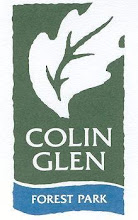HIGH HOPES FOR NEW ROPES AT COLIN GLEN TRUST
Colin Glen Trust has officially announced the launch of an exciting new high ropes course at Colin Glen Forest Park, Belfast. Due to be finished at the beginning of June, this unique activity centre will be the first of its kind in Northern Ireland and will provide an exciting and distinctive recreational offering for local people and visitors to the area.

Having secured investment from a
number of different funders i
ncluding Biffaward, Alpha, and Lagan Rural
Partnership, Colin Glen Trust undertook a comprehensive process of consultation
and planning with a building contract finally being awarded to the world
renowned Bulgarian company, Walltopia. Walltopia, who specialise in the construction
of artificial climbing walls and climbing apparatus, have constructed in over
35 countries and are extremely excited about bringing their unique design to
Northern Ireland for the first time ever.
The ropes course will be 15 meters in
height and participants will have the opportunity to choose from a high ropes
course at 15 meters or a lower, less daunting course at 5 meters. The course
offers numerous team building and ground-based activities along with an
incredible power fan descender, climbing wall and a unique double 65 meter zip
line which sets it apart from anything else available in Ireland and is
guaranteed to provide a thrilling experience.
The course will serve as an active
outdoor adventure but will also be well configured to serve as an educational
tool. It will cater for a large variety of people ranging from young children
and families to veteran ‘adrenaline junkies’ and fitness fanatics. It is perfect for corporate events and will
be highly useful for effective team building in local organisations and
businesses.
Colin Glen
High Ropes Course will also promote active outdoor learning and assist in mental and physical
development for everyone, engaging learners through motivational,
dynamic delivery of tasks from a team of highly skilled individuals. The team
employed will deliver quality outdoor learning which will also be highly
beneficial for schools.
The experience will force students outside of their individual ‘comfort zones’
as they learn to work as a team in a challenging outdoor environment. It will
enable students to learn essential skills which will prepare them for
education, employment and life.
The project will enhance the West
Belfast area by increasing tourism and providing economic support with a huge
influx of visitors expected from all over Ireland and the UK. Mr Pat McCann
from Lagan Rural Partnership commented “We are very proud to support such a
dynamic and exciting project and believe that it will assist in our on-going
efforts to improve the local socio-economic environment. Colin Glen High Ropes
Course will be a fantastic addition to Northern Ireland tourism and we are
proud of our involvement in the project.”
Furthermore, the new outdoor
adventure site at Colin Glen Forest Park will assist in the campaign to tackle
on-going anti-social behaviour by providing youths with an affordable, fun and
attractive place to visit. For a number of years, Colin Glen Forest Park has
been synonymous with anti-social behaviour and vandalism, thus it will have a
massive impact on efforts to eliminate this and in turn raise the profile of what
is a stunning forest park. Colin O’Neill, Chief Executive of Colin Glen Trust
believes that “It will be an excellent way to bring life into Belfast
hills and to extend the use of the park”.
The high ropes course will be
facilitated by an online website which will be an excellent source of
information and will present visuals of the project from the moment building
work commences. This will also be
supported by social media sites such as Facebook and Twitter which will provide
an interactive medium for potential visitors. Visitors can use the website to
book a range of activities ranging from £5 - £20 using a debit or credit card.
The website is due to go live in May and anyone planning to take a visit to
Colin Glen High Ropes Course is encouraged to make prior bookings due to the
expected high demand.
Colin Glen Trust are now running a
competition for the naming of the facility and are inviting people to come up
with a catchy name for the high ropes course. To enter, please email john@colinglentrust.org with your suggested name, along with your contact details.
The best name will be selected by 12th April and the winner will
receive a free one hour session on the course for up to 20 people, along with
an invitation to the official launch which will be attended by local press.
Contact Maeve
Fearon for further information, interview or pictures via email maeve@colinglentrust.org or call
02890 614115.











-email.gif)
